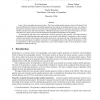42 search results - page 7 / 9 » Reverse Engineering of Legacy Code Exposed |
ASE
2007
13 years 5 months ago
2007
Knowing which associations are compositions is important in a tool for the reverse engineering of UML class diagrams. Firstly, recovery of composition relationships bridges the ga...
SP
2006
IEEE
13 years 11 months ago
2006
IEEE
Linux is the most popular open source project. The Linux random number generator is part of the kernel of all Linux distributions and is based on generating randomness from entrop...
CCS
2010
ACM
13 years 4 months ago
2010
ACM
We present the first sound program transformation approach for automatically transforming the code of a legacy web application to employ PREPARE statements in place of unsafe SQL...
KBSE
2005
IEEE
13 years 11 months ago
2005
IEEE
To realize the benefits of Aspect Oriented Programming (AOP), developers must refactor active and legacy code bases into an AOP language. When refactoring, developers first need...
VEE
2012
ACM
12 years 1 months ago
2012
ACM
Process-level virtualization is increasingly being used to enhance the security of software applications from reverse engineering and unauthorized modification (called software p...

